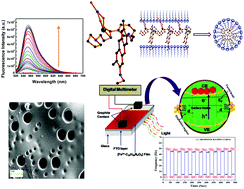当前位置:
X-MOL 学术
›
Photochem. Photobiol. Sci.
›
论文详情
Our official English website, www.x-mol.net, welcomes your
feedback! (Note: you will need to create a separate account there.)
A turn-on fluorogenic chemosensor for Fe3+ and a Schottky barrier diode with frequency-switching device applications†
Photochemical & Photobiological Sciences ( IF 2.7 ) Pub Date : 2018-03-05 00:00:00 , DOI: 10.1039/c7pp00322f Habib Ali Molla 1, 2, 3, 4 , Rahul Bhowmick 1, 2, 3, 4 , Abu Saleh Musha Islam 1, 2, 3, 4 , Bibhutibhushan Show 1, 2, 3, 4 , Nillohit Mukherjee 4, 5, 6, 7 , Anup Mondal 1, 4, 7, 8, 9 , Mahammad Ali 1, 2, 3, 4
Photochemical & Photobiological Sciences ( IF 2.7 ) Pub Date : 2018-03-05 00:00:00 , DOI: 10.1039/c7pp00322f Habib Ali Molla 1, 2, 3, 4 , Rahul Bhowmick 1, 2, 3, 4 , Abu Saleh Musha Islam 1, 2, 3, 4 , Bibhutibhushan Show 1, 2, 3, 4 , Nillohit Mukherjee 4, 5, 6, 7 , Anup Mondal 1, 4, 7, 8, 9 , Mahammad Ali 1, 2, 3, 4
Affiliation

|
A novel highly sensitive and selective fluorescent chemosensor L has been synthesized and characterized by various physicochemical techniques. In 3 : 7 water : MeCN (v/v) at pH 7.2 (10 mM HEPES buffer, μ = 0.05 M LiCl), it selectively recognizes Fe3+ through 1 : 1 complexation resulting in a 106-fold fluorescence enhancement and a binding constant of 8.10 × 104 M−1. The otherwise non-fluorescent spirolactam form of the probe results a dual-channel (absorbance and fluorescence) recognition of Fe3+via CHEF (chelation enhanced fluorescence) through the opening of the spirolactam ring. We have also carried out fluorescence titration and anisotropy (r) studies in pure water in the presence of SDS (sodium dodecyl sulphate). Based on the dependence of FI (fluorescence intensity) and r on [SDS] it was proposed that the probe is trapped between two SDS monolayers which again interact among themselves by π⋯π stacking. As a result, there is an increase in FI up to [SDS] ∼ 7 mM – a phenomenon reminiscent of aggregation-induced enhancement of emission (AIEE). Beyond this concentration of SDS (7 mM), micelle formation takes place and the π⋯π stacked polymer now becomes a monomer and is trapped inside the micellar cavity. As a result, there is a decrease in FI at [SDS] > 7 mM. But for anisotropy, it increases with [SDS] beyond 7 mM. Ligand, metal, and SDS interactions are well established through different optical and morphological studies. [L–Fe(NO3)]2+ thin films on FTO (Fluorine-doped Tin Oxide) glass substrates have been designed with the help of the spin-coating deposition technique. The deposited film of thickness 1.6 × 10−5 cm is well characterized by optical band gap calculation with a direct band gap, εg ∼ 1.6 eV. FESEM was also performed for the [L–Fe(NO3)]2+/FTO film. The current–voltage characteristics were measured by the two-probe technique. Light-dependent exciton generation was carried out by taking the top and bottom contacts with graphite paste on FTO and on the [L–Fe(NO3)]2+ films for the measurement of switching behavior. The response ratio curve for the light-induced frequency-switching phenomena has been obtained. The frequency taped here is the oscillation frequency of the photo-generated electron and the hole in an exiton. Thus, the light-induced frequency-switching behavior and Schottky barrier diode characteristics of the material were established.
中文翻译:

用于Fe 3+的开启式荧光化学传感器和具有频率切换设备应用的肖特基势垒二极管†
已经合成了新颖的高灵敏度和选择性的荧光化学传感器L,并通过各种物理化学技术对其进行了表征。在pH值为7.2的3:7水:MeCN(v / v)(10 mM HEPES缓冲液,μ = 0.05 M LiCl)中,它通过1:1络合选择性选择性识别Fe 3+,导致106倍荧光增强和结合常数8.10×10 4 M -1。探针的其他非荧光形式的螺内酰胺通过螺内酰胺环的打开,通过CHEF(螯合增强的荧光)导致Fe 3+的双通道(吸收和荧光)识别。我们还进行了荧光滴定和各向异性(r)在SDS(十二烷基硫酸钠)存在下的纯水中进行研究。根据FI(荧光强度)和r对[SDS]的依赖性,提出将探针捕获在两个SDS单层之间,该两个SDS单层之间又通过πingπ堆叠相互作用。结果,FI增加到[SDS]〜7 mM,这种现象让人联想到聚集诱导的发射增强(AIEE)。超过此浓度的SDS(7 mM),发生了胶束形成,π⋯π堆积的聚合物现在成为单体,并被困在胶束腔内。结果,[SDS]> 7 mM时FI降低。但是对于各向异性来说,[SDS]超过7 mM时会增加。通过不同的光学和形态学研究可以很好地确定配体,金属和SDS的相互作用。[ L利用旋涂沉积技术设计了FTO(氟掺杂氧化锡)玻璃基板上的–Fe(NO 3)] 2+薄膜。厚度1.6×10的淀积膜-5厘米是公用的直接带隙,其特征在于,光学带隙计算ε克〜1.6eV的。还对[ L -Fe(NO 3)] 2+ / FTO膜进行了FESEM 。电流-电压特性是通过双探针技术测量的。光依赖性激子的产生是通过在FTO和[ L -Fe(NO 3)] 2+上与石墨膏进行顶部和底部接触来进行的薄膜用于测量开关行为。得到了光致频率切换现象的响应比曲线。此处记录的频率是光生电子和出口中的空穴的振荡频率。因此,建立了材料的光诱导频率切换行为和肖特基势垒二极管特性。
更新日期:2018-03-05
中文翻译:

用于Fe 3+的开启式荧光化学传感器和具有频率切换设备应用的肖特基势垒二极管†
已经合成了新颖的高灵敏度和选择性的荧光化学传感器L,并通过各种物理化学技术对其进行了表征。在pH值为7.2的3:7水:MeCN(v / v)(10 mM HEPES缓冲液,μ = 0.05 M LiCl)中,它通过1:1络合选择性选择性识别Fe 3+,导致106倍荧光增强和结合常数8.10×10 4 M -1。探针的其他非荧光形式的螺内酰胺通过螺内酰胺环的打开,通过CHEF(螯合增强的荧光)导致Fe 3+的双通道(吸收和荧光)识别。我们还进行了荧光滴定和各向异性(r)在SDS(十二烷基硫酸钠)存在下的纯水中进行研究。根据FI(荧光强度)和r对[SDS]的依赖性,提出将探针捕获在两个SDS单层之间,该两个SDS单层之间又通过πingπ堆叠相互作用。结果,FI增加到[SDS]〜7 mM,这种现象让人联想到聚集诱导的发射增强(AIEE)。超过此浓度的SDS(7 mM),发生了胶束形成,π⋯π堆积的聚合物现在成为单体,并被困在胶束腔内。结果,[SDS]> 7 mM时FI降低。但是对于各向异性来说,[SDS]超过7 mM时会增加。通过不同的光学和形态学研究可以很好地确定配体,金属和SDS的相互作用。[ L利用旋涂沉积技术设计了FTO(氟掺杂氧化锡)玻璃基板上的–Fe(NO 3)] 2+薄膜。厚度1.6×10的淀积膜-5厘米是公用的直接带隙,其特征在于,光学带隙计算ε克〜1.6eV的。还对[ L -Fe(NO 3)] 2+ / FTO膜进行了FESEM 。电流-电压特性是通过双探针技术测量的。光依赖性激子的产生是通过在FTO和[ L -Fe(NO 3)] 2+上与石墨膏进行顶部和底部接触来进行的薄膜用于测量开关行为。得到了光致频率切换现象的响应比曲线。此处记录的频率是光生电子和出口中的空穴的振荡频率。因此,建立了材料的光诱导频率切换行为和肖特基势垒二极管特性。











































 京公网安备 11010802027423号
京公网安备 11010802027423号